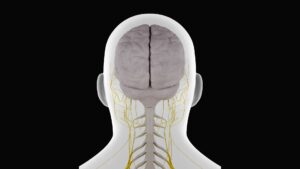The femoroacetabular is one of the largest, strongest and most flexible joints in the human body. During gait our hips give us power and stability, and when jumping, these ball-and-socket joints are able to withstand enormous impact. Yet the hips and their supporting structures often take a beating due to aging, overuse, and trauma causing the brain to reactively guard the area with spasm or pain. For decades, lateral hip pain has been blamed on injury to the fluid-filled bursa sacs covering the greater trochanter, thus the name trochanteric bursitis (TB). Yet, today many of us have come to realize that many cases of hip “bursitis” are actually due to wear and tear of the gluteus medius/minimus tendons beneath the bursa and/or IT-band irritation overlying it. (Image 1.)

Causes, Symptoms, Assessments and Graded Exposure Stretching
Greater trochanteric pain syndrome (GTPS) can result from direct impact to the lateral hip, prolonged single-legged weight bearing, instability due to aging, sports injuries, and IT-band bursa irritation from repetitive movements. Clients usually present with dull lateral hip pain sometimes radiating into the thigh. It’s not uncommon for clients to report that their pain worsens at night and when rising from a chair after having been seated for an extended period of time. During GTPS assessment, the client’s pain may be aggravated by direct palpatory trochanter pressure, single-legged weight bearing (30-seconds), and resisted hip abduction. Yet, I’ve found the hip de-rotation test demonstrated in Image 2. to be the most effective.

If the assessments point to GTPS, the treatment goals are to increase blood flow and hydration to the area while restoring elasticity to the tissues that may be compressing the bursa against the greater trochanter. Since many GTPS clients experience stiffness and restricted ROM on the affected side, restoring normal hip ROM can be achieved using graded exposure stretching as demonstrated in Image 3. To relieve IT-band pressure on the bursa, I like to apply slow sustained elbow pressure to the tensor fascia lata while the client performs slow pelvic tilts (see accompanying video). These techniques can also be aimed at decreasing length deficits of the glutei, hamstrings, quadriceps and piriformis. Home retraining advice should focus on strengthening the hip abductors, external rotators and extensor. This combo will help improve the client’s gait deficits, hip biomechanics and pelvic stability.

In chronic cases, the client must understand that the pain is not pathologic and that, in time it will resolve itself… with or without therapy. To help lower the client’s threat level, encourage them to have peace with their pain during the therapy process. Assure them that by working as a team, the painful condition will be resolved.
References
1. Bunker TD, Esler CN, Leach WJ. Rotator-cuff tear of the hip. J Bone Joint Surgery, 1997.
On sale this week only!
Save 25% off the Essential MAT Assessments course!
NEW! Now available in the enhanced video USB format!
In the “Essential MAT Assessments” course, you’ll learn how to perform 130 essential orthopedic and osteopathic tests, as well as anatomic landmark exams to get to the bottom of your client’s pain complaint. Save 25% this week only! Offer expires Monday June 2. Click the button below for more information and to purchase the course. Upon completion, you will receive 16CE hours and a certificate of completion to display in your office. BONUS: Purchase the home study program and receive instant access to our comprehensive eCourse at no extra cost. Begin your journey to mastery today!








